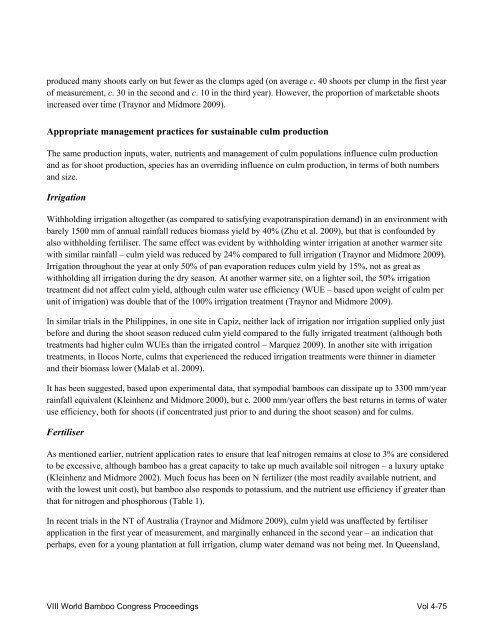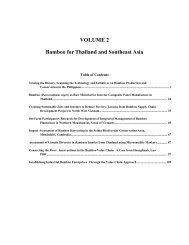WBC-VIII-Vol.4 – Resources – Forestry, Plantations and ... - BambuSC
WBC-VIII-Vol.4 – Resources – Forestry, Plantations and ... - BambuSC
WBC-VIII-Vol.4 – Resources – Forestry, Plantations and ... - BambuSC
You also want an ePaper? Increase the reach of your titles
YUMPU automatically turns print PDFs into web optimized ePapers that Google loves.
produced many shoots early on but fewer as the clumps aged (on average c. 40 shoots per clump in the first year<br />
of measurement, c. 30 in the second <strong>and</strong> c. 10 in the third year). However, the proportion of marketable shoots<br />
increased over time (Traynor <strong>and</strong> Midmore 2009).<br />
Appropriate management practices for sustainable culm production<br />
The same production inputs, water, nutrients <strong>and</strong> management of culm populations influence culm production<br />
<strong>and</strong> as for shoot production, species has an overriding influence on culm production, in terms of both numbers<br />
<strong>and</strong> size.<br />
Irrigation<br />
Withholding irrigation altogether (as compared to satisfying evapotranspiration dem<strong>and</strong>) in an environment with<br />
barely 1500 mm of annual rainfall reduces biomass yield by 40% (Zhu et al. 2009), but that is confounded by<br />
also withholding fertiliser. The same effect was evident by withholding winter irrigation at another warmer site<br />
with similar rainfall <strong>–</strong> culm yield was reduced by 24% compared to full irrigation (Traynor <strong>and</strong> Midmore 2009).<br />
Irrigation throughout the year at only 50% of pan evaporation reduces culm yield by 15%, not as great as<br />
withholding all irrigation during the dry season. At another warmer site, on a lighter soil, the 50% irrigation<br />
treatment did not affect culm yield, although culm water use efficiency (WUE <strong>–</strong> based upon weight of culm per<br />
unit of irrigation) was double that of the 100% irrigation treatment (Traynor <strong>and</strong> Midmore 2009).<br />
In similar trials in the Philippines, in one site in Capiz, neither lack of irrigation nor irrigation supplied only just<br />
before <strong>and</strong> during the shoot season reduced culm yield compared to the fully irrigated treatment (although both<br />
treatments had higher culm WUEs than the irrigated control <strong>–</strong> Marquez 2009). In another site with irrigation<br />
treatments, in Ilocos Norte, culms that experienced the reduced irrigation treatments were thinner in diameter<br />
<strong>and</strong> their biomass lower (Malab et al. 2009).<br />
It has been suggested, based upon experimental data, that sympodial bamboos can dissipate up to 3300 mm/year<br />
rainfall equivalent (Kleinhenz <strong>and</strong> Midmore 2000), but c. 2000 mm/year offers the best returns in terms of water<br />
use efficiency, both for shoots (if concentrated just prior to <strong>and</strong> during the shoot season) <strong>and</strong> for culms.<br />
Fertiliser<br />
As mentioned earlier, nutrient application rates to ensure that leaf nitrogen remains at close to 3% are considered<br />
to be excessive, although bamboo has a great capacity to take up much available soil nitrogen <strong>–</strong> a luxury uptake<br />
(Kleinhenz <strong>and</strong> Midmore 2002). Much focus has been on N fertilizer (the most readily available nutrient, <strong>and</strong><br />
with the lowest unit cost), but bamboo also responds to potassium, <strong>and</strong> the nutrient use efficiency if greater than<br />
that for nitrogen <strong>and</strong> phosphorous (Table 1).<br />
In recent trials in the NT of Australia (Traynor <strong>and</strong> Midmore 2009), culm yield was unaffected by fertiliser<br />
application in the first year of measurement, <strong>and</strong> marginally enhanced in the second year <strong>–</strong> an indication that<br />
perhaps, even for a young plantation at full irrigation, clump water dem<strong>and</strong> was not being met. In Queensl<strong>and</strong>,<br />
<strong>VIII</strong> World Bamboo Congress Proceedings Vol 4-75




